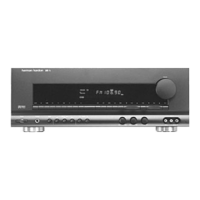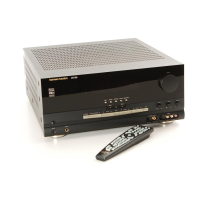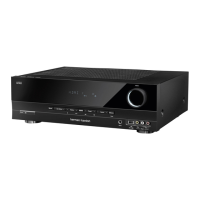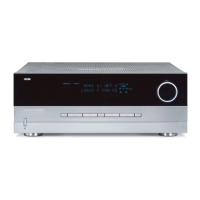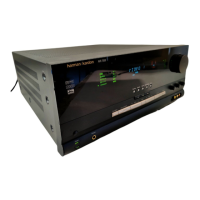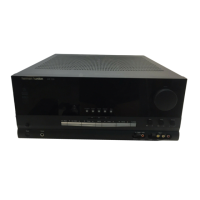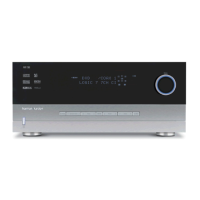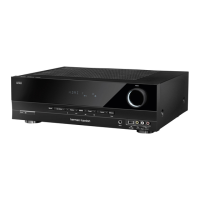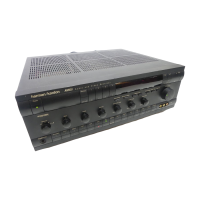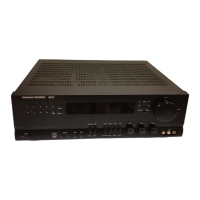Do you have a question about the Harman Kardon AVR 7550HD and is the answer not in the manual?
Key safety instructions for proper and safe use of the apparatus.
Notes on wet location marking, service, and outdoor use warnings.
Guidelines on cleaning the unit and safely moving the apparatus.
FCC compliance information and unpacking instructions for the receiver.
Introduction to the Harman Kardon AVR 7550HD, its features, and capabilities.
Details on audio, video, and digital audio input/output connections.
Highlights user-friendly features and lists all supplied accessories.
Illustration and overview of the AVR's front panel controls and display.
Explains the purpose and operation of each front panel button and feature.
Diagram and overview of all input/output connections on the AVR's rear panel.
Explains various rear panel connections like digital audio, network, and analog ports.
Covers fan vents, preamp outputs, A-BUS port, speaker outputs, and power inputs.
Illustration and explanation of the main remote control's buttons and functions.
Details the operation of remote buttons for source selection, navigation, and alphanumeric input.
Explains functions like Volume, Mute, Sleep Timer, and AVR Settings access.
Illustration and explanation of the Zone 2 remote control's buttons and functions.
Explains operation of Power, Mute, Source Selectors, and Volume for Zone 2.
Overview of typical home theater components and multichannel audio concepts.
Introduction to different surround sound technologies and algorithms.
Instructions for connecting speakers and subwoofers, including wiring and polarity.
Guidance on connecting various source components to the AVR.
Details digital and analog audio connection methods for source devices.
Explains HDMI, composite, S-video, and component video connections.
Details on video connections and instructions for connecting AM/FM antennas.
Information on connecting the RS-232 port for system control via computer.
Instructions for positioning front, surround, and subwoofer speakers for optimal sound.
Steps for planning system connections, including video and audio connection choices for sources.
A table to record device types and assign them to AVR sources and inputs.
Guide on assigning sources to specific video and audio inputs based on preferences.
Step-by-step guide for connecting source devices, TV, speakers, antennas, and accessories.
Instructions for connecting the AVR to the internet and setting up remote IR control.
Explains methods for distributing audio and video to other rooms in a multizone setup.
Connecting video displays and IR control devices for multizone operation.
Steps for plugging in power cords, inserting batteries, and programming the remote.
Advanced remote programming for changing device types, learning codes, and deleting data.
Steps for the first-time power-on of the AVR 7550HD.
Guide to navigating and using the AVR's on-screen menu system for configuration.
Guide to using the EzSet/EQ II system for automatic speaker calibration and setup.
Assigning correct audio and video input connections to each source device.
Details for 6-/8-channel inputs, resolution settings, HDMI bypass, and renaming sources.
Adjusting lip sync and input levels for sources to optimize audio and video synchronization.
Configuring Zone 2 audio/video sources and trigger output behavior.
Procedures for powering on the AVR and adjusting volume levels.
Explanation and adjustment of Dolby Volume for enhanced audio clarity and consistency.
Details on mute, sleep timer, audio effects, video modes, headphones, and source selection.
Instructions for operating the built-in AM/FM tuner for radio reception.
Instructions for connecting and operating the XM Satellite Radio tuner.
Playing audio/images from USB and accessing internet radio streams.
Playing media from a PC network and making audio/video recordings.
Connecting and operating an iPod via The Bridge II dock for playback and control.
Operating an iPod in manual mode for viewing photos and videos.
Choosing and adjusting surround sound modes for different audio sources.
In-depth explanation of audio processing and surround sound capabilities.
Discusses playback options for analog and digital audio signals and surround modes.
Adjusting Dolby settings and manually configuring speaker parameters.
Manually setting speaker crossover frequencies and measuring speaker distances.
Navigating the manual setup menus for speaker configuration.
Setting speaker crossover frequencies and subwoofer modes for optimal bass management.
Fine-tuning speaker distance settings for precise sound staging.
Manually calibrating speaker channel output levels for balanced sound reproduction.
Detailed explanation of audio effects settings like Dolby Volume, Tone, Treble, Bass, LFE, EQ.
Adjusting video settings for optimal picture quality, including picture modes.
Selecting picture modes and adjusting aspect ratio for different content and displays.
Adjusting noise reduction, cross color, flesh tone, black level, deinterlacing, and film mode.
Step-by-step guide for manually adjusting custom picture settings like brightness and contrast.
Adjusting sharpness and operating the multizone system for playback in other rooms.
Configuring system-wide settings like dimmer, volume units, language, and display options.
Configuring network, volume, language, and menu appearance settings.
Viewing software version and accessing upgrade instructions.
Programming remote control activities (macros) and setting up punch-through controls.
Further details on programming remote control functions like backlight and reset.
Procedures for resetting the AVR's processor and system to factory defaults.
Information on how user settings are retained during power interruptions.
A guide to diagnosing and resolving common operational problems with the AVR.
Default connection recommendations for various source components.
Default settings for surround modes, video, audio, and zone configurations for each source.
Continuation of default source setting defaults for USB, Internet Radio, Network, and other sources.
Default speaker and channel settings for different audio input types and listening positions.
Default speaker distance and A/V Lip Sync delay settings.
Worksheets to record source-specific settings for surround modes, video, audio, and zone.
Continuation of source settings worksheets for USB, Internet Radio, Network, and other sources.
Table to record custom audio effects settings for various sources.
Table to record custom video modes and picture adjustment settings for sources.
Default and customizable surround mode selections for different audio sources.
Table to record brand and code numbers for programming the remote control.
Table to record custom system settings like dimmer, volume units, and language.
Table to record network configuration details like IP address and DNS settings.
Table to record custom Zone 2 settings for source, volume, and carrier output.
Detailed descriptions of Dolby surround modes and their incoming bitstream/signal compatibility.
Detailed descriptions of Dolby and DTS surround modes and their compatibility.
Detailed descriptions of DTS and Logic 7 surround modes and their compatibility.
Detailed descriptions of Stereo and 2-Channel surround modes and their compatibility.
Reference list mapping remote control buttons to functions for various devices.
Continuation of the remote control function list, mapping buttons to functions for more devices.
Final part of the remote control function list, mapping buttons to functions for various devices.
Technical specifications for the audio performance, power output, and input sensitivity.
Technical specifications for the video processing and display capabilities.
General technical specifications including power requirements, dimensions, and weight.
| Channels | 7.1 |
|---|---|
| Type | AV Receiver |
| HDMI | Yes |
| HDMI Inputs | 4 |
| HDMI Outputs | 1 |
| Video Formats Supported | 1080p |
| THD | 0.07% |
| Input impedance | 47 kOhms |
| Signal-to-noise ratio | 100 dB |
| Frequency response | 10 Hz - 100 kHz |
| Total Harmonic Distortion | 0.07% |
| Input Sensitivity | 200 mV |
| Video Upconversion | Yes |
| USB Port | Yes |
| Bluetooth | No |
| Wi-Fi | No |
| Audio Formats Supported | Dolby TrueHD, DTS-HD Master Audio |
| Audio Decoding | Dolby TrueHD, DTS-HD Master Audio |
